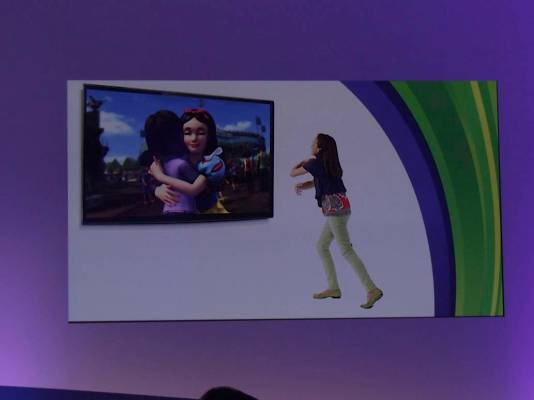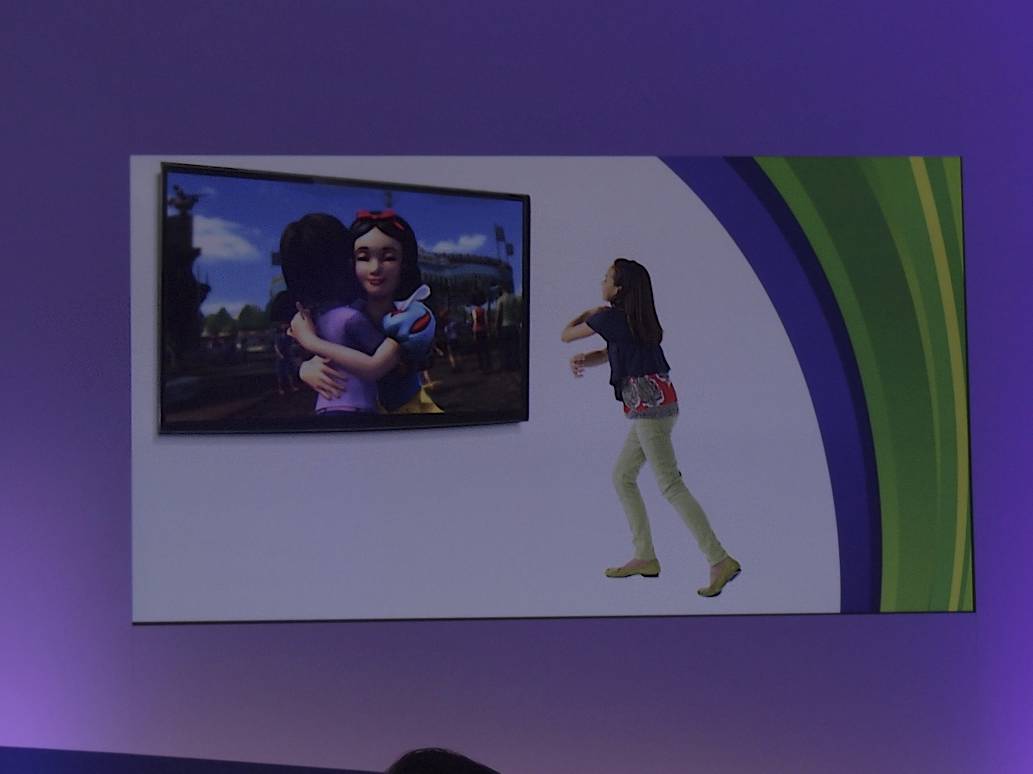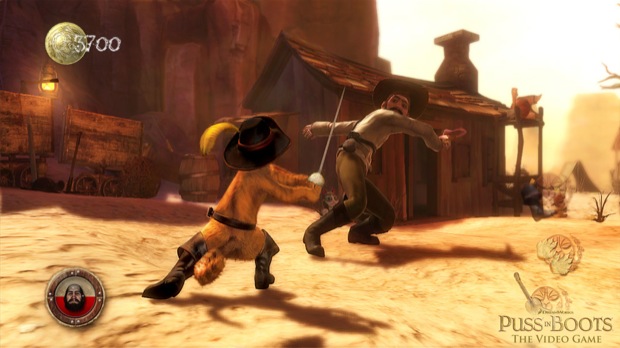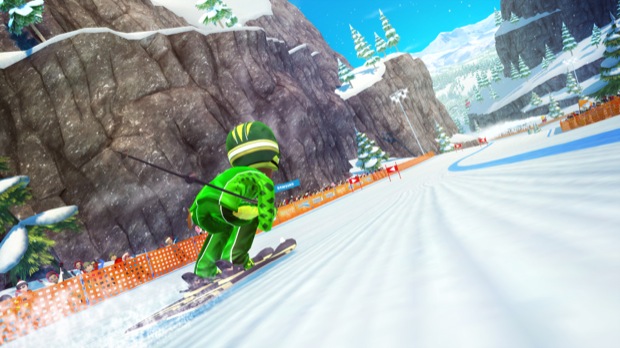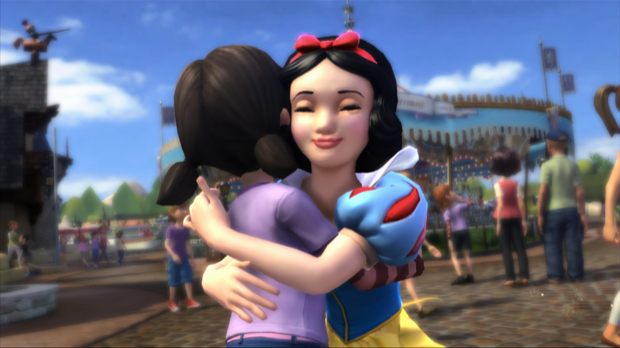I took my six-year-old son Kasper to Microsoft’s Kinect For Kids event yesterday in hopes of better understanding Microsoft’s efforts at grabbing the younger demographic. While he’s already an avid weekend gamer, I wondered if Microsoft’s latest immersive play solutions would stir him in anyway. I discovered two things: that the Kinect for Kids initiative, as evidenced by the image above, is a sometimes sad but immersive Kinect playspace and that Microsoft has a very narrow age window into which they release most of their games.
First, the good stuff. I’m pleased to report that the Kinect version of Puss In Boots is the winner this season with a protagonist that allows for some fun, immersive play. You’re Puss (he of the boots), late of Shrek fame, and you’re outfitted with a sword, hat, and a pair of botas of Spanish leather. You slash, kick, and punch your way through the game, occasionally jumping from rope to rope as you make your way through the slums of Far Far Away. It’s one of the more immersive adventure games we saw and Kasper loved it. A close second was Kinect Star Wars although the interactions and gameplay are still too wonky for my liking. The on-screen Jedi flail around and it feels more like a rails shooter than anything else.
Another winner was Kinect Sports 2. This adds skiing and tennis to the mix and it worked as well as the original Sports which is to say that the faux sports were realistic enough to simulate actual sports.
Then we degenerate into the interactive “little kids” games, Once Upon A Monster, an interactive Sesame Street and National Geographic “show,” and the Disneyland Adventures. These games simulate, in order, being a monster, Sesame Street, and Disneyland. For example, in Once Upon a Monster you become Elmo or Cookie Monster and run around in the woods and balance on stuff. In Disneyland Adventures you go to Disneyland. In the National Geographic interactive television program you pretend to be a bear eating moths. This is Microsoft’s checkbook development writ large. By paying for the hearts, minds, and trust of parents wholesale through these brands, they don’t have to generate it themselves.
To recap, my own six-year-old test subject, then, found Puss In Boots quite fun, Star Wars Kinect pretty rocking, and the Disney and Elmo stuff pretty juvenile, even for, well, a juvenile. He also enjoyed Kinect Sports 2 because he’s an avid (if reckless) skier.
The games are truly interactive and immersive, that much is true. You can actually play as one of your favorite Sesame Street characters and, as we reference above, you can “hug” princesses at Disney World. But these are video games. There is some basic reading and counting involved for the wee ones, but these games are aimed at the youngest kids and will quickly bore children who have already left the Sesame Street demographic. Microsoft is caught in the traditional trap of so-called “educational” gaming: either the educational portion is too preachy or the game is too thin. Games that got it right – Mavis Beacon, Math Blaster, Oregon Trail – are classics because teachers and parents treated them as treats given once the regular work was done.
The question I have as a parent is where is the value in simulating Disneyland? In creating mini-games based on Sesame Street characters? In dumping an interactive portion into a show about a man who tamed a grizzly bear? I don’t want to be a wet blanket, but how are these games teaching anything? The anti-marketer in me, for example, find Disneyland Adventures cynically mercenary, an attempt to give pressure kids into wanting to go to Disneyland. No harm in that, I agree, but why else does it exist? The image of a child hugging the air is the saddest I’ve ever seen and to suggest that a digital simulacrum of Snow White will please a child is wildly off-base. It’s this image that my ire returns to, like my tongue probing a sort spot in my mouth: that Disney and Microsoft think you can hug nothingness.
As I said before, Microsoft has a very narrow window into which it must inject its kids’ content. Children under 2 shouldn’t watch TV at all while pre-schoolers and first graders are already forming some very strong attachments to Pokemon, Bratz, and other brands. Microsoft hasn’t yet cracked the Nintendo code which, as I noted before, is essentially the creation of umami for the heart. Xbox hasn’t quite reached that family demographic in a way that makes sense for them and, like Sony, they’ve depended on marquee mature titles to keep them afloat. Kinect is clearly for kids – adults flailing around in a living room is an invitation to spill the scotch but, as of yet, Kinect Adventures and maybe the dancing game have grabbed any traction.
But what happens in the year or two between Sesame Street and early literacy? Does Elmo look as appealing to a kid who is familiar with more mature fare? While I know these games aren’t in it for long-term enjoyment, isn’t it a little cynical to hope that kids will pester their parents to buy the game (“It’s educational! It’s Disney!”) only to have them abandon it once they realize Cookie Monster is for babies?
My son enjoyed the adventure games and I’m certain my daughter will enjoy some of the Disney games although, at 3, she lacks the coordination to actually play with the Kinect. The helicopter parent in me wants Microsoft to keep its nose out of my kids childhood whereas the neophile wants to see where this immersive gameplay is headed. In the end, neither will win and Kasper will start to play New Super Mario Brothers for a few minutes ever weekend, abandoning Digi-Minnie and Mickey to their soulless kingdom while we, if forced, will walk the streets of the real Disneyland as a family.
